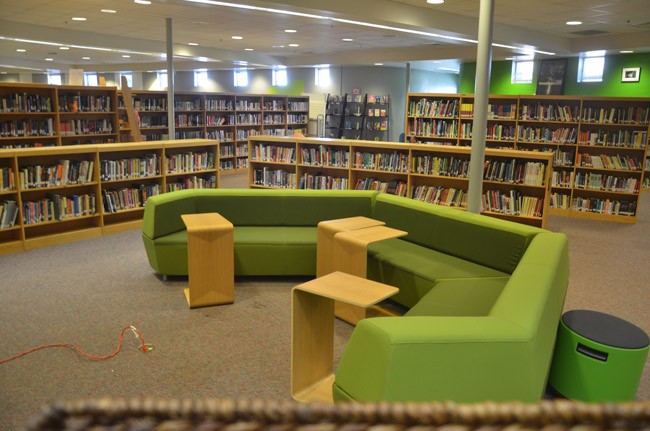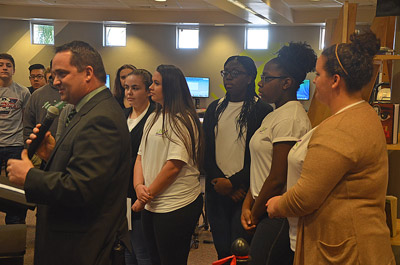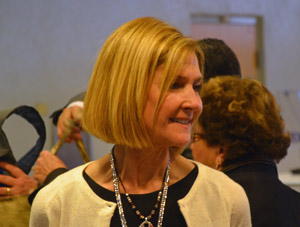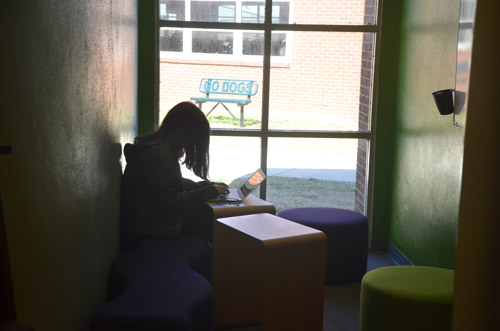
Leave it to Flagler’s prize-rich Community Problem Solvers to change the way we think about libraries, or media centers, or the new term those solvers are applying to the former media center at Flagler Palm Coast High School: the Bulldog Learning Commons.
The books are still there, if on a couple of fewer shelves. So are the desks, the tables, the chairs, the reference desk, even the detector at the door to foil nostalgics who still get a kick out of swiping the odd relic of print. But it’s the look and feel of the place that’s changed. The lay of the land is different. It’s more collegial, in the dual sense of the term: it feels more like a college library, and it invites students to approach their work more collegially, in cooperative groups, at their ease, on cushy, bouncy and rolling furniture, in slightly more isolated alcoves or in individual carrels.
“Kayla and I have been working on this for about a year now,” 11th grader Judy Colindres said, referring to Kayla Dance, also in 11th grade. “Our goal was to try to get more people involved in the media center, so I definitely say we solved the promotion part of it to get teachers and students to know what new facilities we have—new furniture and spaces available for them to study, to work together, to work individually, to collaborate, work on projects, whatever they need to do, it’s available for them.”
Colindres, Dance and three other team Community Problem Solvers team members—11th graders Ivana Moore and Vasthi Malvoisin and 10th grader Sarah Dance—made the new commons their year’s project in their problem solving initiative, which they’ll be entering in state competition in late March and early April in Orlando, and possibly, if they qualify, at international competition in Michigan this summer.

“I saw them eying things down and they’re going to go back with their teams,” Oliva said, “I can promise you they’re going to say we’re going to try to put some more innovative approaches, adding additional collaborative learning spaces such as this one, I’d imagine pretty soon.”
Oliva saw the project as part of the evolution of the meaning of libraries, going back to his time as principal at Flagler Palm Coast High School. “We used to have very good, philosophical conversations about what is the role of a media specialist what is the role of a media center when information is so much more easily available. When I was in high school growing up, if you wanted to conduct information, we had to go to the library or the media center and pull out an encyclopedia and use the Dewey Decimal System and a card catalogue. That access to information is different. It’s interesting how information is so readily available, but the skills of validating, applying and being able to find platforms to create content based on the information available is definitely one of the major shifts we see in this common learning area.”
When every student has a media center in the palm of the hand, it’s time to change the name and purpose of a school library.
And so gone are the Star Trek-like arrays of oversize Apple computer screens that once dominated one end of the room. Not so long ago those arrays were the pride and joy of schools that could show them off. That was before the district started doling out free Apple Macbooks to every student, making its own computer stations as obsolete as the old style computer lab in colleges. What oversize screens remain in FPC’s commons—and there are a few—are along one wall, where so-called Tidebreak stations have been set up, enabling students to hook their laptops to the larger screen for collaborative work sessions.
Instead of all those Apple stations, an entire segment of the library floor has opened up into an airy, comfortable lounge-like area to study or hang-out, half coffee shop (without the waiters), half study hall, but with oddly ergonomic furniture. “We added different types of furniture that would accommodate different types of learning styles,” Kayla Dance said. “We provided the standard table and chair for students who learn best that way. We added these buoy chairs that move and hop around, for students that are a little more fidgety or like to move a lot. They can stay focused and still have that ability.

“And all the furniture is mobile, it can be redesigned and reimagined,” says Dusty Sims, the principal, noting another feature of the commons: fluidity is now a constant.
The work started last year under former principal Lynette Shott and continued under Sims, with between $10,000 and $20,000 from the school’s capital budget underwriting the improvements, Sarah Reckenwald, a learning commons specialist—as opposed to the old title: media specialist—said.
“We have had college representatives come in to do presentations for our students here and they’ve looked at it and said exactly that, ‘this reminds me of the spaces that we have.’ We’ve had students who go and do summer internships and summer programs at colleges and they come back and say, this reminds me of the college I was at this summer. That’s what we want to inspire in our students, to say this is the space you can come to collaborate, that you can come to work, that you can come to work on your projects. All of the space is open to you. You just let us know what you want and what you need, and we’re going to make it happen for you.”
![]()





























Leave a Reply